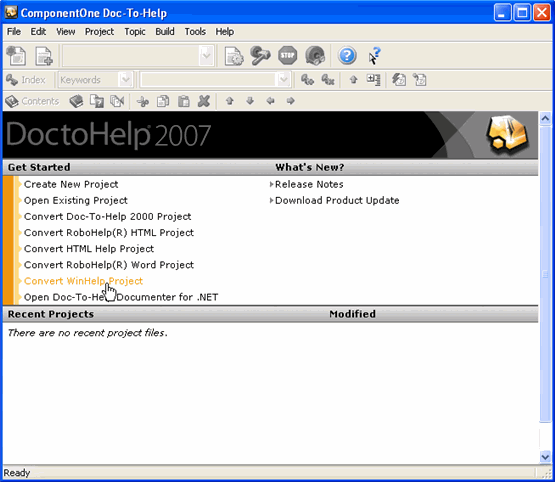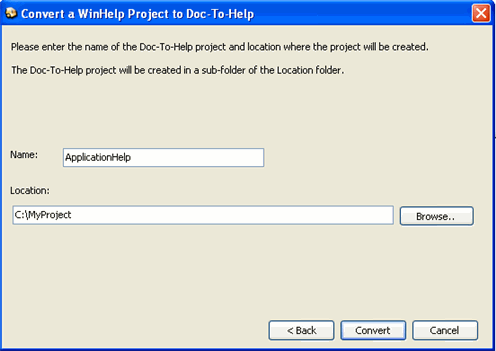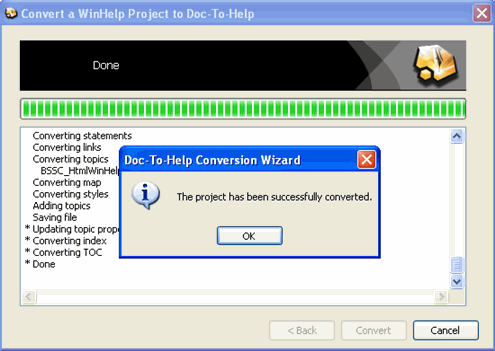You can convert a WinHelp project produced with any help authoring tool other than RoboHelp to a Doc-To-Help project. You need a WinHelp project (files .HPJ, .CNT, etc.) to do that. If you only have an .HLP file, you can still do it, but first you need to decompile it to a WinHelp project using, for example, the freeware HelpDeco utility.
If your WinHelp is produced by RoboHelp and you have the source RoboHelp project, do not use the generic converter, use the RoboHelp Word Ė Doc-To-Help converter instead. The generic WinHelp converter does not convert RoboHelp-specific features.
Files:
All files in the original project folder and its subfolders are copied to the Doc-To-Help project folder. This is done to ensure that external files that may be referenced in the project source files are present in the converted folder and donít cause broken links. If you see files that you know are not needed, you can delete them manually.
Source documents (Word .RTF files included in the project) are converted to Doc-To-Help format. For example, WinHelp hotspots are converted to D2HML hotspots, and so on; please see the following conversion information. Other files are copied to the destination directory unchanged.
Source documents located outside the original project directory are not copied and not converted, with a warning issued in the conversion log.
Graphic files (help images, included in statements such as {bmc}) located outside the project directory remain in their places and their paths in the documents are changed to an absolute path with a warning in the conversion log.
Files included in the BAGGAGE section of the project are not copied to the destination directory unless they are located inside the source project directory. If you need those files, copy them manually to an appropriate location in the project directory.
A special directory _defbmp is created in the converted project directory containing standard WinHelp bitmaps (bitmaps supplied by Help Workshop) such as bullet.bmp, shortcut.bmp, etc.
Styles and templates:
Styles and style appearance in the source documents are preserved in conversion. Converted documents have a Doc-To-Help template, C1H_NOMARGIN.DOT, attached to them, so the author can use Doc-To-Help styles. However, the template does not change the appearance of the styles already used in the source document, because the check box Automatically update document styles in the converted Word documentís Tools|Options menu is unchecked. If you check that check box, the styles appearance can change, because it will be defined by the C1H_NOMARGIN.DOT template.
The target template, which is set using the HelpTarget.Template property in the converted Doc-To-Help project, is set to (None) to preserve the appearance of the source documents in the help target. You can change it to one of the standard Doc-To-Help templates or to your own customized template if you want to control target appearance by a template.
The style of the heading of each topic in Doc-To-Help must be one of the active paragraph styles, those styles that define a topic when Doc-To-Help compiles the document. For a topic with the first paragraph formatted with a style without an outline level (non-active style), its first paragraph is reformatted with a new style with the postfix (Topic) added in the end of the style name; the new style is inherited from the original style. For styles with outline levels (active styles) that are used in the original documents in a mixed way, both for formatting topic headings and for formatting paragraphs that are not topic headings, the paragraphs that are not topic headings are reformatted with a new style with (Nontopic) added in the end of the style name; the new style is inherited from the original style.
Topics:
A Doc-To-Help topic is created in the converted project for each WinHelp topic. A WinHelp topic ID becomes a topic link tag and the value of the topicís AsciiName property. If a topic has an alias in the project file, that alias is also added to the collection of the topicís link tags.
Topic properties and TopicType:
Some topic properties are implemented in Doc-To-Help via topic types. For example, you canít assign windows to individual topics directly, but you can set Topic.TopicType to a topic type that has a specific window in the TopicType.Window property. To enable this mechanism, topic types are created in the converted project as necessary, having the necessary property values, and these topic types are assigned to the Topic.TopicType property, as needed, to specify various topic properties.
Topic properties:
Topic title ($ footnote) is converted to the Topic.DisplayTitle property specified by a D2HML hot spot (style C1HTopicProperties) in topic text.
Topic title specified in table of contents (TOC) is converted to the Topic.ContentsTitle property specified by a D2HML hot spot (style C1HContentsTitle) in topic text.
Topic window (> footnote) is converted to the Topic.TopicType.Window property.
Topic macro (! footnote) is converted to the Topic.WinHelpMacro property.
Topic.TopicType.Nonscrolling is set to True when a topic heading paragraph in the source document has its Word paragraph format setting Keep with next = True.
Topic.TopicType.Midtopic is set to True for topics that are mid-topics, that is, bookmarks in their parent topic rather than separate topics. According to WinHelp rules, such topics are characterized by the absence of a page break before their first paragraph.
TOC:
Table of Contents is converted to Doc-To-Help TOC.
Index keywords:
Index keywords are converted to Doc-To-Help index keywords. They appear on the Index tab in Doc-To-Help. Keywords are defined by D2HML hot spots in topic text (style C1HIndexInvisible), so they can be modified in Doc-To-Help either on the Index tab of the Project Editor or in the topic text using D2HML.
See Also (A-keywords):
A-keywords are converted to Doc-To-Help groups. They appear on the Index tab in Doc-To-Help. Groups are defined by D2HML hot spots in topic text (style C1HGroupInvisible), so they can be modified in Doc-To-Help either on the Index tab of the Project Editor or in the topic text using D2HML.
Links:
Jump and pop-up links (including those defined by macros JI, PI) are converted to D2HML hot spots (styles C1HJump, C1HPopup) in topic text.
Keyword links:
Keyword links (macros KL, JK) are converted to D2HML hot spots (style C1HKeywordLink) in topic text.
A-links (See Also links):
A-links (macro AL) are converted to D2HML hot spots (style C1HGroupLink) in topic text.
Windows:
Windows specified in the project are converted to Doc-To-Help windows with the same names. Doc-To-Help window properties are set for a WinHelp target based on the values of corresponding properties in the source project.
Map IDs:
Map IDs are converted to topic context IDs in the Doc-To-Help project. Context IDs are defined by D2HML hot spots in topic text (style C1HContextID), so they can be modified in Doc-To-Help either in the topic property browser of the Project Editor or in the topic text using D2HML.
Browse sequence:
Topics included in a browse sequence (having + footnotes) are included in the Doc-To-Help navigation sequence by setting Topic.TopicType.AutoNavigate = True. However, custom browse sequence (+ footnotes with browse code) is not converted, because Doc-To-Help browse sequence is always determined by the topic hierarchy, that is, by positioning of topics inside documents.
Conditional build tags:
Conditional build tags (* footnotes) are converted to Doc-To-Help attributes. You can see the attributes in the Attributes node of the Doc-To-Help Project Editor tree view.
Conditional build tags in project sections INCLUDE, EXCLUDE:
In the generic WinHelp converter, attributes created from conditional build tags are checked or unchecked in the help targets in the Doc-To-Help project depending on whether they are appear in [INCLUDE] or in the [EXCLUDE] section of the project file.
Topic-level conditional build tags:
Conditional build tags specified in the properties of a WinHelp topic (* footnotes) are converted to a D2HML topic properties hot spot (style C1HTopicProperties) in the Doc-To-Help topic text.
Macros:
Macros defined in the project file for the entire help (CONFIG section) are converted to the WinHelpMacro property in Project Settings.
Macros defined in the project file for a window (CONFIG:window section) are converted to the Window.WinHelpMacro property.
Macros defined for a topic (! Footnote) are converted to the Topic.WinHelpMacro property.
Macros defined in macro hotspots in topic text are converted to Doc-To-Help WinHelp macro comments in topic text unless they are jump, pop-up or K-/A-links. In the latter case they are converted to D2HML hotspots.
Notes: WinHelp macros have effect only in the WinHelp target; they are ignored in all other targets.
Doc-To-Help has a limitation of 255 characters for macro string length. Macro strings that exceed that limit are truncated, with a warning in the conversion log.
Help images:
Help images (bitmap statements {bmc}, {bml}, {bmr}) are converted to linked pictures (Word {INCLUDEPICTURE} field).
Hotspot images:
Hotspot images (SHED images, segmented hypergraphics) are converted to Doc-To-Help image maps, images with hot spots. Image maps can then be explored and edited using the Doc-To-Help Image Map Editor.
Buttons:
Help buttons ({button} statements) are converted to D2HML hot spots (styles C1HJump, C1HPopup, C1HkeywordLink, C1HGroupLink) with property DisplayAsButton = True.
Help multimedia and embedded windows:
Help multimedia ({mci} statement) is not converted because it is not supported in Doc-To-Help.
Embedded windows ({ew*} statements) are not supported, with the exception of those generated by RoboHelp graphical buttons, which are converted to images formatted as Doc-To-Help hotspots (RoboHelp Word converter only).
To convert a WinHelp project:
1. Open Doc-To-Help 2007 and click Convert WinHelp Project.

2. Browse, select an .hpj project file and click Open.
3. Review the location and click Next.

4. Enter the name of the Doc-To-Help project to be created in the Name text box.
5. Browse for a location for the new project.

6. Click the Convert button to begin the conversion. A window appears showing the conversion process.
7. Once the conversion is complete, click OK.

8. Click the Close button to close the Convert dialog box. Your new Doc-To-Help project opens in the project editor. You can begin customizing and building your help files.